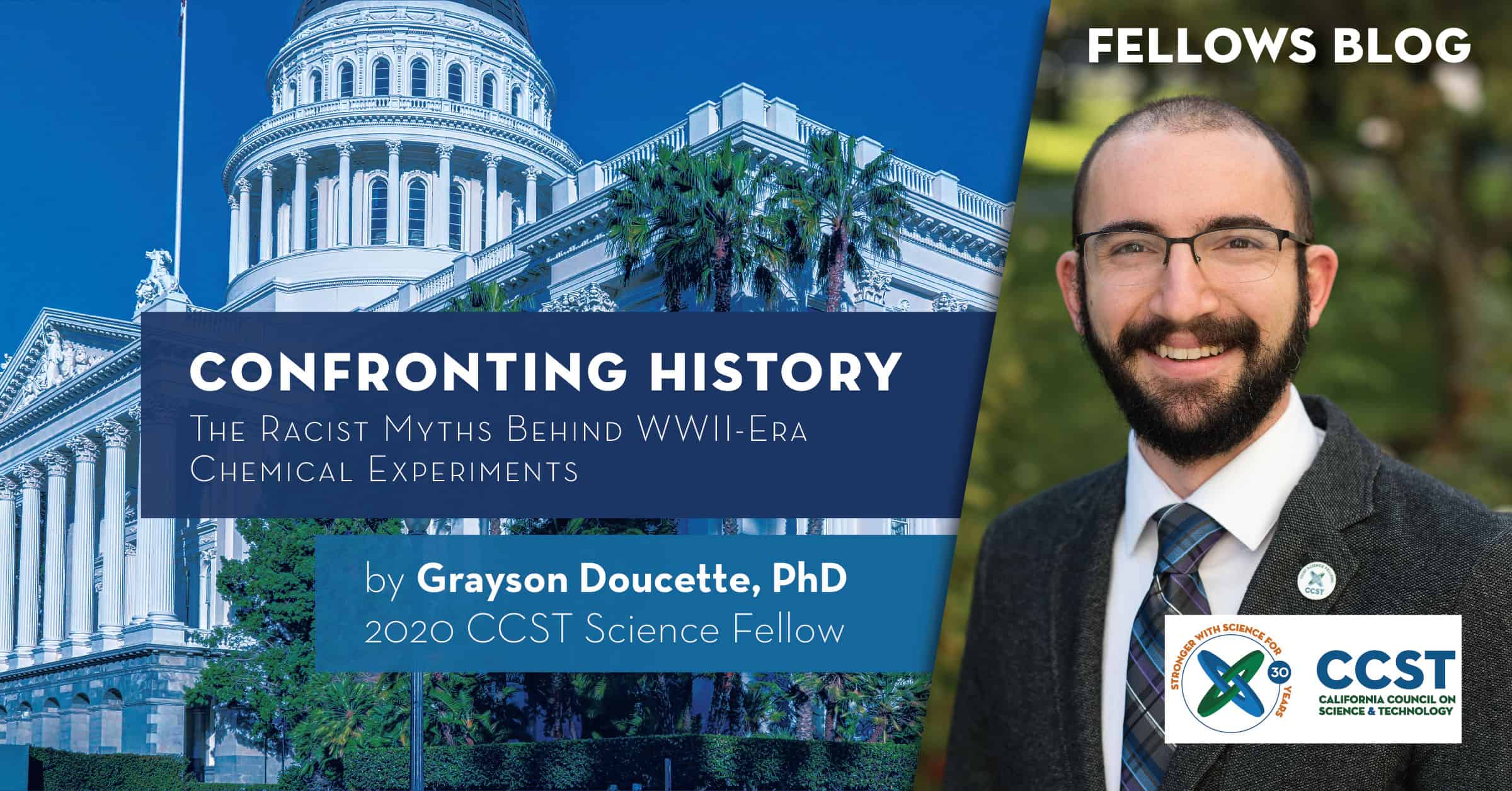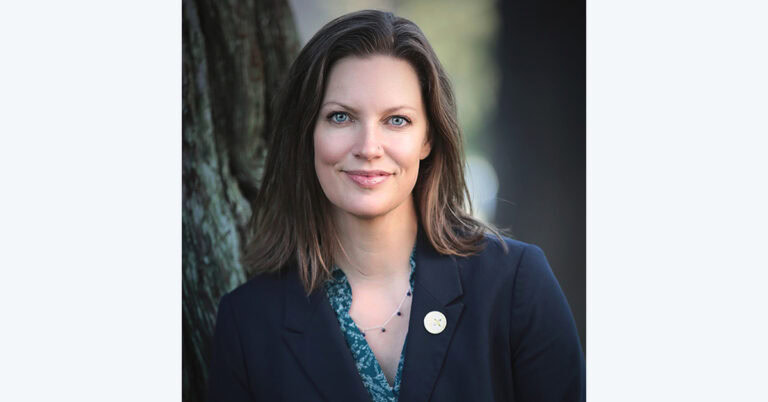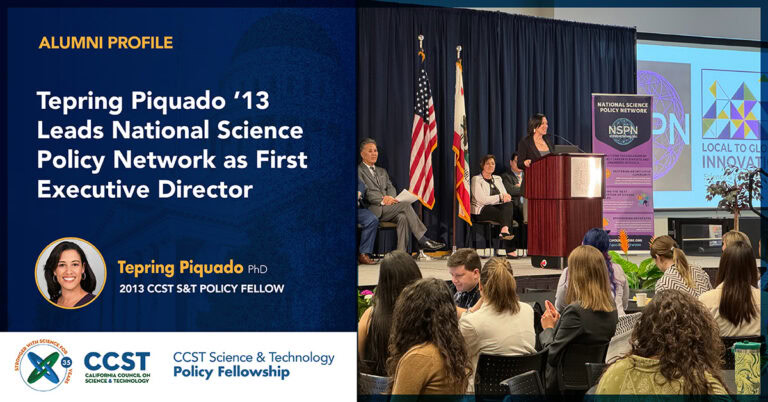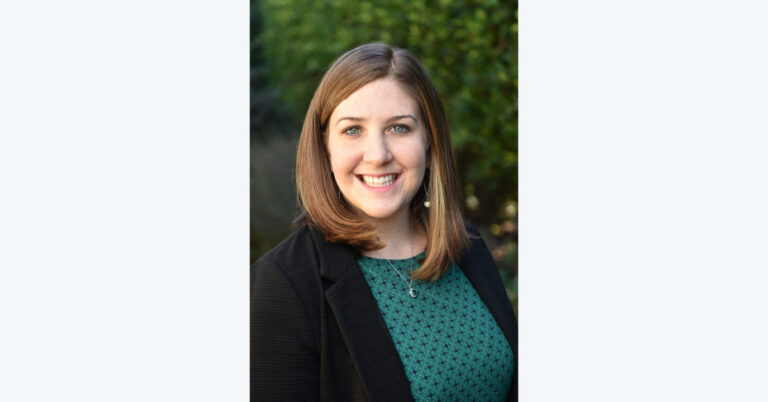Development Specialist
Confronting History: The Racist Myths Behind WWII-Era Chemical Experiments
December 16, 2020 | CCST Newsroom, CCST S&T Policy Fellows
Grayson Doucette is a 2020 CCST Science & Technology Policy Fellow who was placed in the California State Senate Committee on Natural Resources and Water. Grayson received a PhD in Materials Science from Penn State University. His dissertation focused on controlling how molecules interact with one another to learn what makes a more efficient next generation solar panel. He received a BS in Materials Science from Virginia Tech.
Growing up as a military brat, our family proudly discussed the military as ahead of its time in terms of social equality. In fact it was eighty years ago, in 1941, that President Roosevelt signed Executive Order 8802, stating “there shall be no discrimination in the employment of workers in defense industries and in Government, because of race…” and seven years later, in 1948, President Truman issued Executive Order 9981, officially integrating the military. This happened the same year as Sipuel v. Board of Regents of the University of Oklahoma, 4 years before Brown v. Board of Education, and 16 years before the Civil Rights Act.
With the discussion of these milestones growing up, I believed that the armed forces had largely achieved racial equality well ahead of the rest of the nation, and as I began my undergraduate pursuit of a Materials Science degree, I similarly viewed science as something that was inherently objective. As much as graduate school changed my views of objectivity and equality in academia, serving as a CCST Science & Technology Policy Fellow has been a chance to see firsthand not only how policies have constructed structural inequities and how they can be remade to address them, but also how science and policy are considered at a systems level by decision makers. This includes identifying gaps and biases in research and data and how they can contribute to harmful policies or widen existing equity gaps. On a personal level, the killings of George Floyd, Breonna Taylor, and more prompted even deeper reflection into where gaps exist in my own story.
As much as graduate school changed my views of objectivity and equality in academia, serving as a CCST Science & Technology Policy Fellow has been a chance to see firsthand not only how policies have constructed structural inequities and how they can be remade to address them, but also how science and policy are considered at a systems level by decision makers.
Reflecting on the two historic Executive Orders, they are remarkable milestones, but I know that these two idealistic timestamps don’t reflect the historical treatment of all Americans in the armed forces. One major example includes chemical experimentation based on racist myths, highlighting this imperfect history and the importance of scientists confronting this history to avoid repeating it.
In 1993, chemical experiments conducted from World War I until 1975 were declassified. At least nine race-based experiments using chemical agents like mustard gas were included—published only 5 years after Roosevelt’s 1941 declaration against employment discrimination based on race. These experiments were based on racist myths propagated by white scientists regarding the physiology of Black, Indigenous, and People of Color (BIPOC) compared to white people.
One such racist myth that persists today, though disproven, is the myth that Black skin (the epidermis) is thicker than white skin. In reality, there are greater variations of epidermal thickness depending on location on the body than due to the human concept of race. While this specific myth may not have been the cornerstone of chemical weapons experiments, it played a role. Military scientists exposed American forces to mustard gas – which does significant damage, potentially fatal, to the human body once it penetrates the skin layers – in race-based experiments that Dr. Susan Smith suggests were primarily aimed at identifying an “ideal chemical soldier”. The rationale was that “if [Black or brown soldiers] were more resistant, they could be used on the front lines while white soldiers stayed back, protected from the gas”. These physically damaging experiments, unsurprisingly, found no significant race-based differences. The myth that race affected susceptibility to chemical weapons also likely served as part of the rationale for exposing Japanese-Americans to mustard gas to predict the effects of World War II battlefield use on Japanese combatants.
These soldiers existed in an America where they were disparaged for the color of their skin, standing in the shadow of hope that their service and sacrifice would help change societal views, such as NPR’s reporting of Tom Matsumoto who felt it would “prove he was a good United States citizen.” Their stories remind us that part of dismantling white supremacy is lifting the veil on all of its impacts on our history and our own lives.
For me, growing up believing that the armed forces had largely achieved racial equality, and that science was inherently objective, I entered my undergraduate education with significant blind spots. It took numerous years to understand the harm that these incomplete paradigms have on Black and brown Americans every day, and I am still learning. As I’ve learned to think about policy, and as a white man in the policy space, I recognize there is still a gulf of knowledge and understanding that I need to cross as I work to help construct policies that equitably serve all Californians.
###
About the California Council on Science and Technology
The CCST Science & Technology Policy Fellowship trains scientific thinkers to be policy-savvy, while helping equip California’s policymakers with science-savvy staff. Follow updates from the CCST Science Fellows on Facebook and on Twitter @CCSTFellows. Learn more about CCST Science & Technology Policy Fellowship.
The California Council on Science and Technology is a nonpartisan, nonprofit organization established via the California State Legislature — making California’s policies stronger with science since 1988. We engage leading experts in science and technology to advise State decision makers — ensuring that California policy is strengthened and informed by scientific knowledge, research, and innovation.







